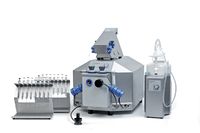Difference between revisions of "High-resolution respirometry"
| (116 intermediate revisions by 15 users not shown) | |||
| Line 1: | Line 1: | ||
{{MitoPedia | {{MitoPedia | ||
|abbr=HRR | |abbr=HRR | ||
|description='''High-resolution respirometry''' | |description=[[Image:O2k-Fluorometer.jpg|200px|left|O2k-FluoRespirometer]] '''High-resolution respirometry, HRR''', is the state-of-the-art approach in mitochondria and cell research to measure respiration in various types of [[mitochondrial preparations]] and [[living cells]] combined with MultiSensor modules. | ||
Mitochondrial function and dysfunction have gained increasing interest, reflecting growing awareness of the fact that mitochondria play a pivotal role in human health and disease. HRR combines instrumental accuracy and reliability with the versatility of applicable protocols, allowing practically unlimited addition and combination of substrates, inhibitors, and uncouplers using the [[Oroboros O2k-technology]]. Substrate-uncoupler-inhibitor titration (SUIT) protocols allow the interrogation of numerous mitochondrial pathway and coupling states in a single respirometric assay. Mitochondrial respiratory pathways may be analyzed in detail to evaluate even minor alterations in respiratory coupling and pathway control patterns. | |||
The O2k-technology provides sole source instruments, with no other available instrument meeting its specifications for high-resolution respirometry. Technologically, HRR is based on the Oroboros O2k-technology, combining optimized chamber design, application of oxygen-tight materials, electrochemical sensors, Peltier-temperature control, and specially developed software features (DatLab) to obtain the unique sensitive and quantitative resolution of oxygen concentration and oxygen flux, with both, a closed-chamber or open-chamber mode of operation ([[TIP2k-Module|TIP2k]]). Standardized calibration of the polarographic oxygen sensor (static sensor calibration), calibration of the sensor response time (dynamic sensor calibration), and evaluation of instrumental background oxygen flux (systemic flux compensation) provide the experimental basis for high accuracy of quantitative results and quality control in HRR. HRR can be extended for MultiSensor analysis by using the [[O2k-Fluo Smart-Module]]. [[Smart Fluo-Sensor]]s are integrated into the O2k to measure simultaneously fluorometric signals using specific fluorophores. Potentiometric modules are available with ion-selective electrodes (pH, TPP<sup>+)</sup>. The [[PB-Module]] extends HRR to PhotoBiology with accurate control of the light intensity and measurement of photosynthesis. The O2k and the NextGen-O2k support all these O2k-Modules. The [[NextGen-O2k]] all-in-one, however, is unique in supporting Q-Redox and NADH-Redox Modules. | |||
|info=[[Oroboros O2k-technology]] | |||
}} | |||
{{Template:Keywords: O2k-technology}} | |||
== | == MitoPedia: O2k and high-resolution respirometry == | ||
::::» [[MitoPedia: O2k hardware]] | |||
::::» [[MitoPedia: DatLab]] | |||
::::» [[MitoPedia: SUIT]] | |||
::::'''»''' [[MitoPedia: Respiratory states]] [[Image:P.jpg|link=OXPHOS capacity|OXPHOS]] [[Image:R.jpg|link=ROUTINE respiration|ROUTINE]] [[Image:E.jpg|link=ET capacity|ET capacity]] [[Image:L.jpg|link=LEAK respiration|LEAK]] - [[Image:ROX.jpg|link=Residual oxygen consumption|ROX]] | |||
::::» [[Respirometry]] | |||
::::» [[MitoPedia: Respirometry]] | |||
::::» [http://en.wikipedia.org/wiki/Respirometry Wikipedia: Respirometry] | |||
::::» [[O2k Applications]] | |||
= | [[Image:O2k-Publications.jpg|left|116px|link=O2k-Publications: Topics|O2k-Publications in the MiPMap]] | ||
::: '''O2k-Publications''' | |||
::::* [[O2k-Publications |O2k-Publications: Chronological]] | |||
::::* [[O2k-Publications: Topics]] | |||
{{Template:Keywords: Oxygen signal}} | |||
::: '''Selected references''' | |||
::::* [[Gnaiger 1995 J Bioenerg Biomembr]] | |||
::::* [[Gnaiger 2001 Respir Physiol]] | |||
::::* [[Gnaiger 2008 POS]] | |||
::::* [[Gnaiger 2020 BEC MitoPathways]] | |||
</div> | |||
</div> | |||
<br /> | |||
{{MitoPedia methods | |||
|mitopedia method=Respirometry, Fluorometry, Spectrophotometry | |||
}} | |||
{{MitoPedia O2k and high-resolution respirometry | |||
|mitopedia O2k and high-resolution respirometry=O2k hardware, O2k-Respirometry, O2k-FluoRespirometry | |||
}} | |||
= | |||
Latest revision as of 09:09, 2 April 2024
Description
High-resolution respirometry, HRR, is the state-of-the-art approach in mitochondria and cell research to measure respiration in various types of mitochondrial preparations and living cells combined with MultiSensor modules.
Mitochondrial function and dysfunction have gained increasing interest, reflecting growing awareness of the fact that mitochondria play a pivotal role in human health and disease. HRR combines instrumental accuracy and reliability with the versatility of applicable protocols, allowing practically unlimited addition and combination of substrates, inhibitors, and uncouplers using the Oroboros O2k-technology. Substrate-uncoupler-inhibitor titration (SUIT) protocols allow the interrogation of numerous mitochondrial pathway and coupling states in a single respirometric assay. Mitochondrial respiratory pathways may be analyzed in detail to evaluate even minor alterations in respiratory coupling and pathway control patterns.
The O2k-technology provides sole source instruments, with no other available instrument meeting its specifications for high-resolution respirometry. Technologically, HRR is based on the Oroboros O2k-technology, combining optimized chamber design, application of oxygen-tight materials, electrochemical sensors, Peltier-temperature control, and specially developed software features (DatLab) to obtain the unique sensitive and quantitative resolution of oxygen concentration and oxygen flux, with both, a closed-chamber or open-chamber mode of operation (TIP2k). Standardized calibration of the polarographic oxygen sensor (static sensor calibration), calibration of the sensor response time (dynamic sensor calibration), and evaluation of instrumental background oxygen flux (systemic flux compensation) provide the experimental basis for high accuracy of quantitative results and quality control in HRR. HRR can be extended for MultiSensor analysis by using the O2k-Fluo Smart-Module. Smart Fluo-Sensors are integrated into the O2k to measure simultaneously fluorometric signals using specific fluorophores. Potentiometric modules are available with ion-selective electrodes (pH, TPP+). The PB-Module extends HRR to PhotoBiology with accurate control of the light intensity and measurement of photosynthesis. The O2k and the NextGen-O2k support all these O2k-Modules. The NextGen-O2k all-in-one, however, is unique in supporting Q-Redox and NADH-Redox Modules.
Abbreviation: HRR
Reference: Oroboros O2k-technology
- »Bioblast links: O2k-technology and HRR - >>>>>>> - Click on [Expand] or [Collapse] - >>>>>>>
- Oroboros Marketplace
- » O2k
- Oroboros Marketplace
- Concept
- » Concentration
- » Coupling-control state
- » Mitochondrial preparations
- » Oxidative phosphorylation
- » Oxygen, dioxygen, O2
- » Oxygen flux
- » Electron-transfer-pathway state
- » Respiration
- » Respirometry; » MitoPedia: Respirometry
- » Substrate-uncoupler-inhibitor titration (SUIT) protocols; » MitoPedia: SUIT
- Concept
MitoPedia: O2k and high-resolution respirometry
- O2k-Publications
- Bioblast links: Oxygen signal - >>>>>>> - Click on [Expand] or [Collapse] - >>>>>>>
- Specific
- O2k-Procedures
- MiPNet O2k-Procedures
- General
- » Oxygen, dioxygen, O2
- » Oxygen calibration - DatLab
- » Oxygen solubility
- » Oxygen solubility factor
- » Oxygen pressure
- » Concentration
- » Activity
- » Pressure - Pascal
- » Barometric pressure
- » High-resolution respirometry
- » OroboPOS
- » Polarographic oxygen sensor
- » MitoFit Quality Control System
- » Sensitivity
- General
- Other keyword lists
MitoPedia methods:
Respirometry,
Fluorometry,
Spectrophotometry
MitoPedia O2k and high-resolution respirometry:
O2k hardware,
O2k-Respirometry,
O2k-FluoRespirometry



